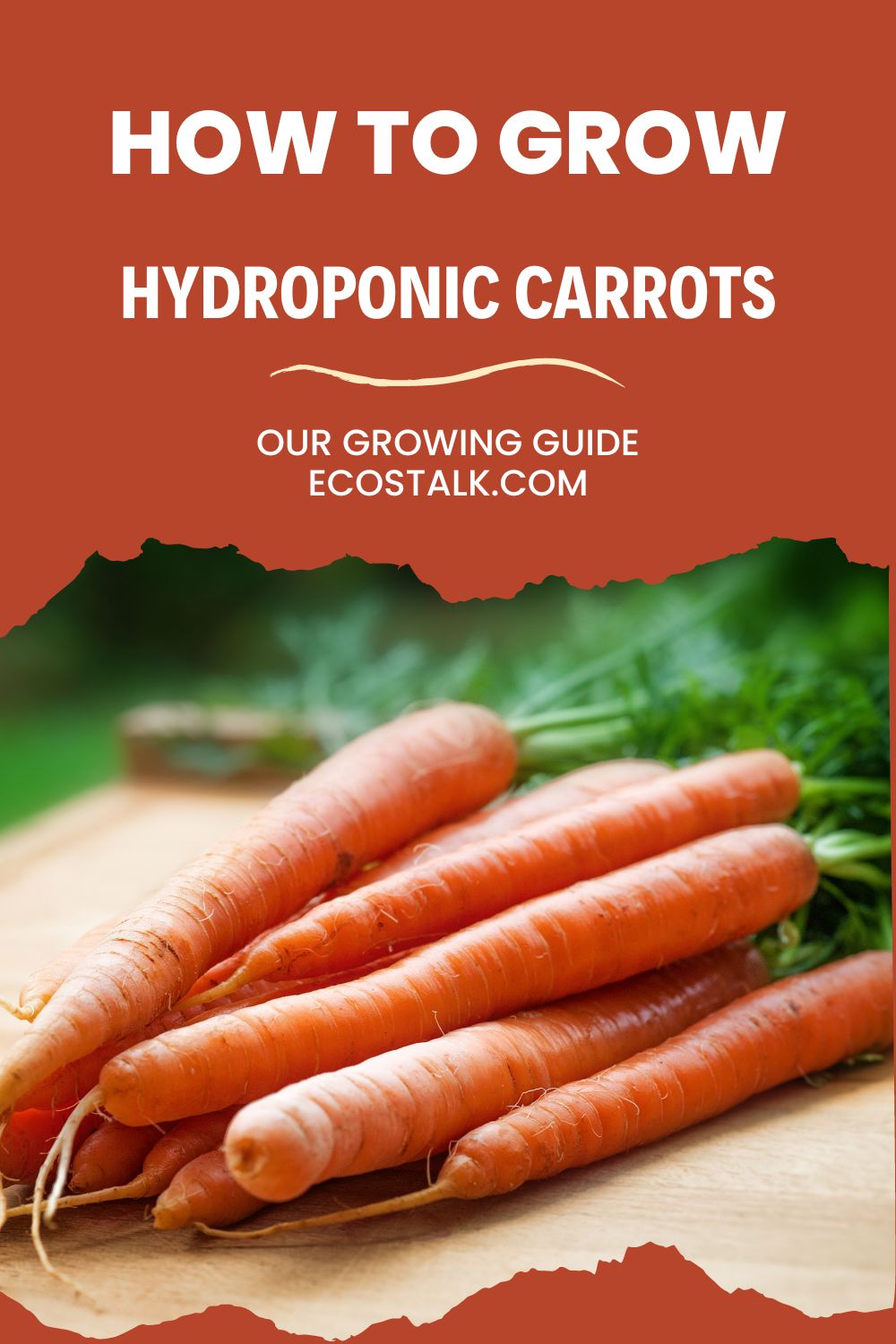Please note that I may earn a small commission from purchases made through product links in this article. As an Amazon Associate I earn from qualifying purchases.
Last updated: May 20, 2023
Learning how to grow hydroponic carrots is a great challenge for a hydroponic gardener.
Carrots are hardy vegetables, but it has specific needs in order to thrive in a hydroponic garden.
In this article we will go through the basic setup that you will need to grow hydroponic carrots.
We will touch on the essential growing conditions for carrots to thrive in a hydroponic environment.
- Can You Grow Carrots Hydroponically?
- Best Types of Hydroponic Carrots to Grow
- How to Grow Hydroponic Carrots
- Practical Tips for Growing Hydroponic Carrots
Can You Grow Carrots Hydroponically?
Yes, of course you can. So what’s the catch?
Root vegetables are typically a bit trickier to grow in a hydroponic system.
Carrots are hardy vegetables that can grow in tough climates, but they don’t like too much moisture, and they need the right amount of space to grow.
Therefore you need to have the right hydroponic setup, and select the right type of carrot to succeed at growing carrots hydroponically.
Best Types of Hydroponic Carrots to Grow
When choosing carrots to grow in a hydroponic garden, there are a few things to consider.
It is important to select varieties that are adaptable to indoor growing conditions, have a shallow root system, and produce well in a soil-less environment.
There are four types of carrots that grow best in a hydroponic garden:
Nantes
This is a popular variety of carrot that is known for its sweet, crisp texture and cylindrical shape.
Developed in France, this carrot is popular for its flavor and crunch factor.
It has a distinct blunt end, instead of a tapered shape like other varieties such as Danvers Carrots.
Therefore it is a good choice for hydroponic gardens, as the blunt end results in shorter roots, which makes it easier to grow in containers.
Chantenay
These carrots are shorter and broader than Nantes carrots.
Chantenay carrots similar to baby carrots but thicker, and can be interchangeable with them in recipes.
Their short length gives them an advantage in hydroponic systems, as they do not require as much growing space, nor do they have long roots.
Danvers
When most of us think about carrots, it is the Danvers carrot that comes to mind.
This variety of carrot is known for its long, tapered shape and deep orange color.
It is a good choice for hydroponic gardens because it is easy to grow and resistant to cracking and deforming.
Miniature
These carrots are small in size and grow quickly, making them an excellent choice for hydroponic gardens.
They are also ideal for small spaces or container gardens.
How to Grow Hydroponic Carrots
1. Pick Which System is Best for Growing Carrots Hydroponically
Carrots and other root vegetables can be more challenging to grow in a hydroponic garden than other water-loving vegetables.
There are various reasons for this.
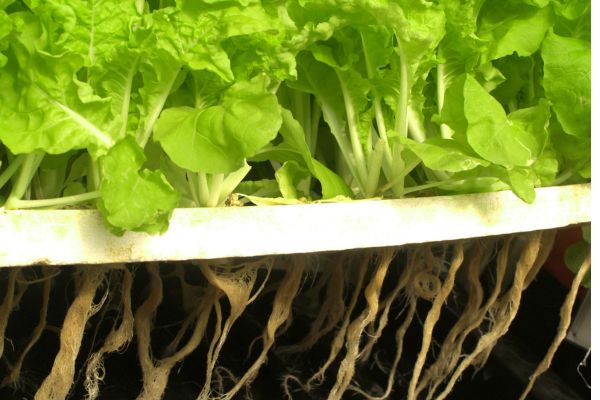
Firstly, is that many root vegetables don’t grow well in standing water or very damp soil, as their roots can quickly start to rot.
Secondly, carrots like other root vegetables, need to be properly spaced out when planted, or else they will fork and deform to grow around one another.
Thirdly, they need large enough containers to allow them to grow to their full size.
If the container is too small, they won’t stop growing when they hit the bottom, instead will just start growing sideways.
Therefore with these challenges in mind, there are two hydroponic systems that we recommend for growing carrots:
Ebb and Flow Hydroponic System
In an Ebb and Flow system, the plants are grown in containers filled with growing media, which are periodically flooded with a nutrient-rich solution before draining away.
Ebb and flow systems work well for growing carrots because they provide a constant supply of nutrients and oxygen to the plants’ roots.
However as the carrots are not constantly submerged in deep water, there is less risk of them developing root rot and other water-related diseases.
Drip Irrigation Hydroponic System
The Drip Irrigation method involves dripping a nutrient-rich solution onto the plants’ growing media, providing them with a regular supply of nutrients and water.
Drip irrigation is a flexible and customizable method that works well for growing carrots in various setups, including vertical gardens.
The amount of water the carrots are exposed to is carefully managed in this system, which helps to avoid rot issues.
In addition to this, a typical drip irrigation system can also be set up with adequate spacing in the container to allow the carrots to grow properly.
Some recommended growing mediums you can use for both of these systems are perlite and clay pebbles.
With proper care and attention, either of these hydroponic methods can help produce healthy, high-quality carrots.
2. Set The Right Temperature for Growing Hydroponic Carrots
The ideal temperature range for growing carrots hydroponically is between 60°F to 70°F (15.5°C to 21°C).
Carrots can tolerate temperature fluctuations of a few degrees above or below this range, but extreme temperature fluctuations can negatively affect plant growth and yield.
3. Calibrate the PH Settings for Hydroponic Carrots
The optimal pH range for growing carrots hydroponically is between 6.0 to 6.5.
Carrots prefer slightly acidic soil conditions.
Therefore pH levels outside of this range can affect the plant’s ability to absorb nutrients, resulting in stunted growth or nutrient deficiencies.
It is essential to monitor pH levels regularly and adjust them as needed to maintain optimal growing conditions for your plants.
4. Create the Nutrient Solution for Growing Your Carrots Hydroponically
Hydroponic carrots require a balanced mix of nutrients to grow properly.
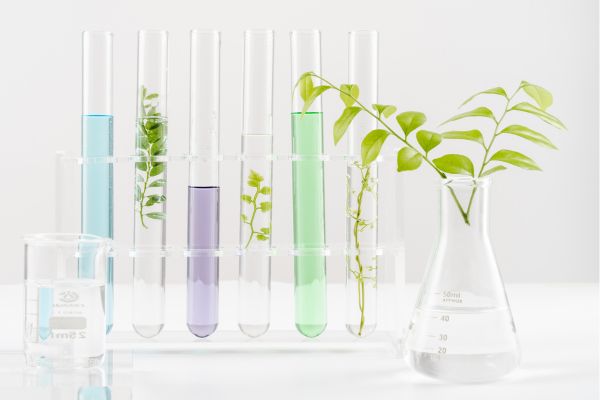
Monitoring the nutrient levels in your hydroponic system regularly and adjusting as needed is just as important as your PH and temperature.
However, it’s not as simple as just pouring in the nutrients separately.
You can start by purchasing a pre-blended nutrient solution to regularly add to your system.
Then if you find your carrots are lacking in any specific nutrients, you can feed supplement solutions to your carrots in addition to your standard solution.
Here are some general recommendations on the nutrient levels needed for growing carrots hydroponically:
Nitrogen
Carrots require moderate levels of nitrogen to grow, with a recommended range of 100-200 ppm (parts per million) in the nutrient solution.
Nitrogen is a critical element for plants to grow well.
It helps carrots grow strong roots, as well as building proteins for healthy cells, and chlorophyll which plants need for photosynthesis to keep growing.
Phosphorus
Phosphorus is important for root development and overall plant growth.
The recommended range of phosphorus is approximately 50-100 ppm for growing carrots.
Additionally, Phosphorus plays a crucial role in energy production within the carrot plant, helping to create and store ATP.
This is the energy used by cells to fuel metabolic processes.
Finally, phosphorus helps carrots tolerate stress, making them more resilient to harsh environmental conditions like drought, cold, and heat stress.
Potassium
Potassium helps to feed the plant’s growth and stress tolerance.
Carrots need a moderate level of potassium, with a recommended range of 150-200 ppm in the nutrient solution.
Calcium
Calcium contributes to cell development of carrots and helps prevent disease.
Carrots should be provided with a relatively high dose of Calcium, with a rough range of 100-200 ppm.
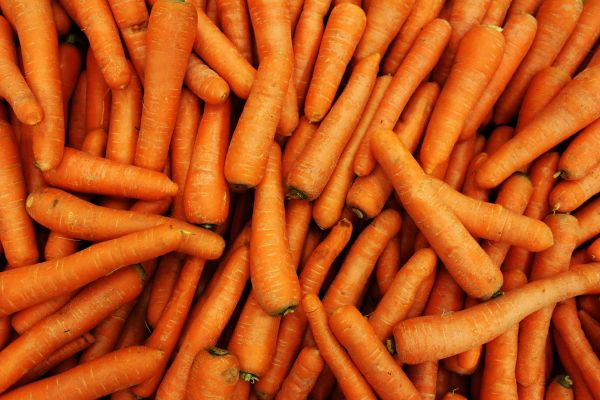
Magnesium
Magnesium is important for photosynthesis and overall plant development.
Carrot should receive an approximate range of 30-50 ppm of Magnesium for optimum growth.
Trace Minerals
Carrots also require small amounts of trace minerals such as iron, manganese, zinc, and copper.
These minerals are typically included in a balanced hydroponic nutrient solution.
5. Set Up the Lighting for Growing Hydroponic Carrots
Hydroponic carrots require a significant amount of light to grow properly.
As a general rule, most vegetable plants require at least 8-12 hours of light per day to thrive.
Carrots are no exception. They require sufficient light to produce healthy foliage, develop strong roots, and produce high-quality roots.
When it comes to grow light settings for hydroponic carrots, there are a few things to consider.
This includes the type of grow light, the plant growth stage, and the desired harvest time.
Here are some general guidelines for the grow light settings for hydroponic carrots:
Light Spectrum
Carrots require a full spectrum of light to grow and thrive.
During the vegetative stage, it’s best to provide a light spectrum that is heavy in blue light, which promotes healthy foliage growth.
However when they reach the flowering and fruiting stage, a spectrum with more red light will encourage the development of high-quality roots.

Light Intensity
The intensity of light needed for hydroponic carrots depends on the plant growth stage and the type of grow light being used.
At first during the vegetative stage, carrots usually require an intensity of about 200 to 400 micromoles/m2/s.
Next comes the flowering and fruiting stage, where the intensity should be increased to around 400 to 600 micromoles/m2/s.
Light Duration
Carrots require at least 8-12 hours of light per day to grow properly.
During the vegetative stage, it’s best to provide 14-18 hours of light per day, while during the flowering and fruiting stage, 12-14 hours of light per day is sufficient.
Light Distance
The distance between the grow light and the plants is also important.
As a general rule, the grow light should be positioned about 12-18 inches (30-45cm) above the plants during the vegetative stage and around 6-12 inches (15-30cm) above the plants during the flowering and fruiting stage.
6. Choose the Right Size Containers to Grow Carrots Hydroponically
As I mentioned earlier, the container size for carrots is very important to allow them to grow to their full size without forking or deformation.
In general, however, the containers should be deep enough to accommodate the long taproots of the carrot plants, which can reach up to 12 inches (30 cm) in length.

The width and length of the container will depend on the number of plants you want to grow and the space you have available.
As a rough guide your carrots should be spaced out at least an inch apart to avoid growing over each other.
It’s also important to ensure that the container has adequate drainage to prevent waterlogging and root rot.
A hydroponic system with a recirculating nutrient solution should have a drain at the bottom of the container to remove excess water.
While a non-recirculating system should have a way to drain the nutrient solution after each watering.
7. How to Germinate Carrot Seeds for Hydroponics
The best way to germinate carrot seeds for hydroponics is to pre-germinate them before planting.
Pre-germinating carrot seeds helps to ensure that they sprout quickly and uniformly, which can improve overall plant growth and yield.
Here is a simple step-by-step guide to pre-germinating carrot seeds for hydroponics:
1. Soak the Seeds:
Place the carrot seeds in a container and cover them with warm water.
Soak the seeds for 12-24 hours to help soften the seed coat and speed up the germination process.
2. Prepare the Germination Medium:
Fill a small container with a moist germination medium, such as vermiculite, perlite, or peat moss.
The medium should be damp but not soaking wet.
3. Plant the Seeds:
Once the seeds have soaked, carefully place them on top of the germination medium, spacing them evenly apart.
Cover the seeds with a thin layer of the germination medium.
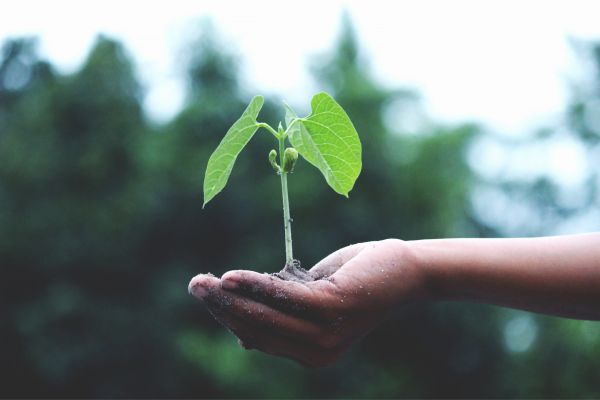
4. Provide Warmth and Moisture:
Place the container in a warm, well-lit area and keep the germination medium moist by misting it regularly.
The ideal temperature for germinating carrot seeds is around 70°F (21°C).
5. Wait for Sprouts:
In about 7-10 days, the carrot seeds should start to sprout.
Once the sprouts are about 1 inch (2.5 cm) tall, they are ready to be transplanted into your hydroponic system.
When doing your transplanting, be sure to handle them gently and plant them at the correct depth.
Carrot seeds should be planted at a depth of about 1/4 to 1/2 inch (0.6 to 1.3 cm).
Ensure that the growing medium is moist and that the sprouts have access to plenty of light and nutrients to support their growth.
8. How Long Does it Take to Grow Carrots Hydroponically
Carrots need around 70 days on average to grow to their full size.
However this is just a rough average, and depends on the type of carrot you are growing, as well as the variables of your hydroponic setup.
A species like Miniature or Chantenay carrots may require less time in optimum conditions for example than a Danvers carrot, as they are smaller carrots at full size.
9. When to Harvest Carrots
Carrots are typically ready to be harvested when they reach maturity, which is about 70-80 days after planting.
Here are a few signs to look for to determine if your carrots are ready to be harvested:
Check the Size:
Gently pull back the growing medium around the top of the carrot to see if it’s the desired size. If it is, you can gently pull the carrot out of the container.
Carrots should be at least 1/2 inch (1.3 cm) in diameter, but you can let them grow larger if you prefer.
The length of the carrot will depend on the variety you’re growing.

Check the Color:
The top of the carrot should be orange, but don’t be alarmed if the lower part of the carrot is a slightly different color. This is normal.
It’s important not to wait too long to harvest your carrots, as they can become tough and woody if left in the ground for too long.
If you’re not sure if all of your carrots are ready to be harvested, you can always pull up one or two and check them before harvesting the rest of your crop.
Practical Tips for Growing Hydroponic Carrots
How to Store Carrots
Carrots can be stored for several weeks if they are kept in the right conditions.
The green tops need to be removed before storing, and if possible the carrots should be kept in their own container.
They should be stored in a cool, dark place with low moisture to avoid rotting.
Other Common Problems when Growing Carrots Hydroponically
Growing carrots hydroponically can be challenging, and there are several common problems that people may encounter.
By being aware of these common problems and taking steps to prevent or address them, it is possible to successfully grow carrots hydroponically.
Root Rot:
Root rot is a common problem in hydroponic systems, and it can be caused by overwatering or poor drainage.
This can cause the roots of the carrot plant to turn brown and mushy, eventually killing the plant.
There are two important things that you can do to avoid root rot.
Firstly select the best hydroponic setup, ebb and flow or drip irrigation are our suggestions, to avoid flooding your plants.
Finally, consistently test and monitor your draining to ensure that water is moving through your system properly.
Nutrient Deficiencies:
Carrots require a balanced mix of nutrients to grow properly, and deficiencies in certain nutrients can cause stunted growth, yellowing leaves, and other issues.
Common nutrient deficiencies in hydroponic systems include nitrogen, phosphorus, and potassium.
Using quality nutrient solutions, backed up by supplements should help to avoid this issue.
You can get nutrient testing kits to help monitor the nutrient balance of your water system too.
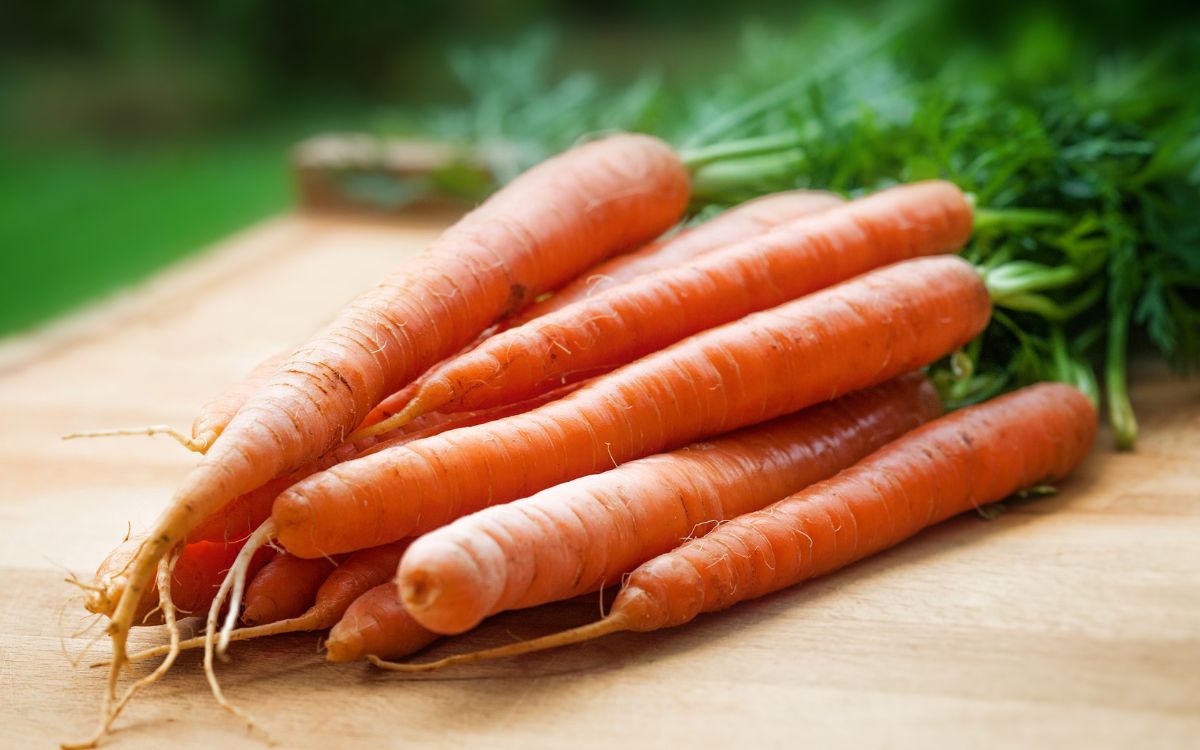
pH Imbalance:
The pH level of the nutrient solution is critical for the health of the carrot plants.
If the pH is too high or too low, the plants may not be able to absorb nutrients properly, which can cause stunted growth, yellowing leaves, and other issues.
Poor Germination:
Carrot seeds can be slow to germinate, and they require a moist environment to do so.
In hydroponic systems, it’s important to ensure that the seeds have enough moisture to germinate, but not so much that they become waterlogged.
You don’t have to germinate your carrots in the same containers as your main setup.
Instead you can germinate in a separate setup specifically for germination with a growing medium like rockwool that keeps your seeds nice and moist.
Once the seeds have started to germinate you can transplant them to your main garden.
How to Protect Hydroponic Carrots from Pests
Carrot flies and other pests can be a problem in hydroponic systems, just as they can be in traditional soil-based gardens.
Some of the most common pests that can affect hydroponic carrot plants include:
Aphids:
Aphids are small, soft-bodied insects that can feed on the leaves and stems of your plants.
They can reproduce quickly and cause significant damage if left untreated.
How to Prevent and Remove Them
If you spot aphids on your carrot leaves, just give them a spray with water mixed with organic dish soap.
The aphids will get trapped in the soap bubbles and you can quickly wipe them off.

Whiteflies:
Whiteflies are small, winged insects that can feed on the leaves, causing yellowing, wilting, and other damage.
How to Prevent and Remove Them
Whiteflies are attracted to humidity, which can be difficult to manage in a hydroponic setup.
So ensure that your growing medium is draining regularly as it should.
However if they have started to infest your plants, you can use a soap spray similar to the one for aphids I described above.
You may also need to dispose of any fully infested plants or containers.
Spider Mites:
Spider mites are tiny arachnids that also feed on the leaves, causing similar issues to Whiteflies.
How to Prevent and Remove Them
Spider mites are the opposite of whiteflies, in that they prefer low humidity.
Cleaning the plants regularly, even by wiping down the leaves may be enough to prevent an infestation.
If you do spot some mites, a soapy water spray also works wonders to remove these annoying creatures.
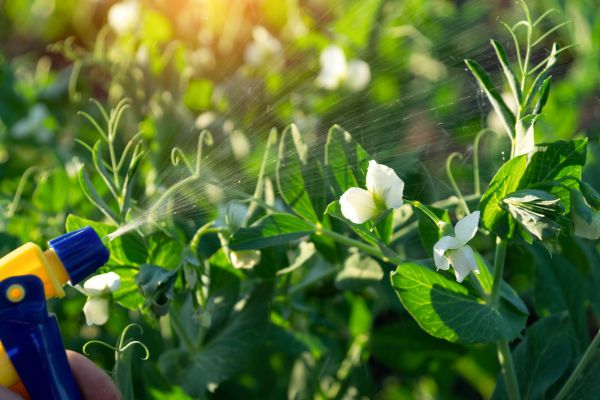
Thrips:
Thrips are small, slender insects that are found on leaves, and can cause other fungal issues like silvering.
How to Prevent and Remove Them
Yellow sticky traps are a good way to attract and monitor if there are any thrips around your plants.
Thrips can be tricky to get rid of. So if soapy water doesn’t work you can try an organic insecticide instead.
You can check out some recommendations for the best natural pesticides for indoor plants here.
Preventing and controlling pest infestations in hydroponic systems can be challenging.
But there are several strategies you can use, including introducing beneficial insects, using organic insecticides, and practicing good sanitation and hygiene in your hydroponic setup.
It’s important to monitor your plants regularly for signs of pest damage and take action quickly to prevent infestations from getting out of control.
In conclusion, carrots are a beautiful and versatile vegetable that has so many good nutrients for your body.
Therefore they are definitely worth the effort of trying to grow in your hydroponic garden.
With the right hydroponic setup, you can grow delicious carrots nearly all year round, without the stress of timing your planting and harvests.
Finally, you may find that many of these tips above will also help you grow other root vegetables in your garden too.
